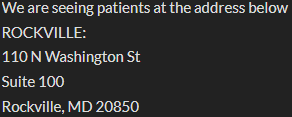PT Explains Reflexive Pattern Therapy™ for Pain
Published on Today in PT on September 16
By Robin Farmer
Pain Arthritis Relief Center, DOM, MSPT, ATC, the co-owner of Advanced Spine & Wellness Center, has developed Reflexive Pattern Therapy™, a unique approach to treating pain. Based in Rockville, Md., the alternative medicine specialist has practiced traditional and alternative medicine for more than 15 years. Bloch discussed with TodayInPT.com how RPT™ works for his patients, who include school-based and professional athletes, and why combining alternative medicine with traditional medicine improves results.
Q: Tell us about your practice.
A: I’ve been practicing since 1994. In 1990, I got my license as an acupuncturist. Since 1995, I’ve had practices. I moved from Miami in 2010 to the Maryland area. All this time, I’ve done holistic, orthopedic pain-type practices, that’s really what the focus is on. It’s usually predominantly knees and backs, but it really doesn’t matter to me where the pain is.
Q: What type of patients do you treat?
A: I treat everyone from kids as young as 6 … to a woman who I think is 102. So I really see the full gamut. There is a lot more pain in kids now than I have seen in the past.
Q: What is RTP™?
A: It is a combination of my physical therapy and acupuncturist background. I have an eclectic approach to pain relief utilizing acupuncture meridians and physical therapy reflexive movements. I discovered an autonomic pattern in the body, and once I identified [the patterns] — which everyone after the age of 6 or 7 have — I corrected the patterns and immediately people feel better. If a patient came in with back pain, I would look for particular autonomic patterns. What’s interesting about RPT™ is if you have back pain, I would never touch your back to get rid of your pain, which flies in the face of most chiropractic care and PT care and massage therapy care and doctors [care]. I look for reflexive tender and ticklish spots in the body, and I utilize reflexive movements along the lines of acupuncture meridians to reset the body. Once the body is reset, a lot of the lower back pain goes away.
Q: How do you explain RPT™ to patients?
A: If your back pain is a light bulb that is not working, to treat that most people work on the light bulb. Some might massage you, some might adjust you and some might stretch you and some might inject you … but I don’t treat the light bulb. I treat the light switch, [which] is how I explain it to patients. The light bulb is the somatic involuntary nervous system. The way we are taught in school, we are taught to go after the [sore] area … to decrease their pain. I don’t want to say that doesn’t work, I just found it takes a lot longer.
Q: Is RPT™ common?
A: I taught about four people. I haven’t taught it in a CU course or the continuing education courses, so it is not common at all. It’s really just here in the Maryland [and Washington, D.C.] areas where I practice. I know what works and I know my patterns. I am working right now to try and prove scientifically, using heart rate variability and other measures, [that] I am working on the autonomic nervous system and that I am actually causing a regulation of that system and how that relates to pain. My technique is between mainstream PT and chiropractic and maybe alternative acupuncture.







